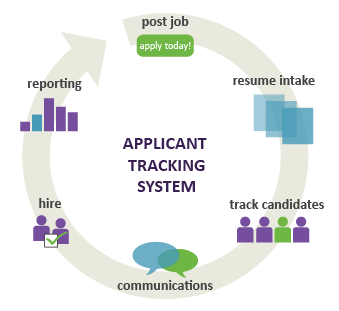- Reduce your recruitment related costs, therefore improving your Cost Per Hire.
- Reduce your recruitment administration time.
- Streamline the entire recruitment process and ensure best practices.
- Reduce the Time to Hire.
- Increase retention and productivity (Increasing the Quality of Hire)
- Improve communication internally and externally.
- Reduce the paperwork within the recruitment process and improve overall efficiencies.
- Improve the strategic decision making process (based upon quality metrics and talent intelligence).
- Improve internal mobility within an organization.
- Improve and automate EEO/ OFCCP monitoring and reporting
- Automation of the requisition approval process
- Facilitates better workforce planning and budgeting.
- Creates a database for the future: Pipelines and bench strength
- Time saving in finding candidates. Stops duplicate submissions.
- Improves your employment brand
- To have a database for just in time recruiting (Pipeline) of candidates you can draw from when needs arise
- Talent intelligence to be able to make informed decisions, especially as it relates to the critical skilled positions.
- Help crystalize your sourcing strategies. IE: where am I deriving the best results from our search efforts and the data support?
- Manages Job fairs, travel expenses, background checks other misc.
- Critical in management of an internal or external recruitment staff
- Measurement and goal setting
- Direct access to social media portals
- Marketing through job postings
Top 5 benefits-

1. Push the best candidates through
Ultimately, the application process is a means of weeding out the weaker candidates and finding the best ones. But it has historically been a long, arduous journey, and one that doesn’t always result in the best possible hire. Prescreen questionnaires and basic résumé-reading are simple tasks that become tedious to human eyes. Recruiting software can examine these items and make efficient candidacy decisions without wearing out.
2. Streamline the application process
Not only are the initial rounds of the recruitment process difficult, they also result in stacks of paperwork and long lists of names, addresses, backgrounds checks, and so on. No HR person wants to sift through all that logistical information during the search for the ideal candidate. The best software consolidates all that into a single database, accessible by people with the right credentials.
3. Interface with online forms
Many job seekers look for positions online or through mobile devices. In fact, as of May 2014, 9 out of 10 job seekers told Glassdoor they expect to use a mobile app during their search sometime in the next 12 months. Applicant tracking tools are digital resources for the increasingly digital world. It wouldn’t make sense maintaining a job postings webpage for the company without the necessary software to collect the applications.
4. Benefits for the applicants
These tools don’t benefit the employers—they help the candidates, too. As hiring management software improves, it becomes easier for candidates to apply and submit their résumés. If a job seeker fits the criteria, his or her application will make it through, unimpeded by human error and not outdone by candidates who try to unfairly boost their credentials. The process is easier, faster, and more direct. Applicants can track the status of the process and won’t have to wait for months only to find their résumé was not accepted.
5. Provide meaningful data
The recruitment process is not only about finding and hiring applicants. Companies spend significant chunks of time and money on advertising—one firm found the average company spends about $173 per new hire. HR’s goal is to bring that number down, and one way to do so is by optimizing their job advertisement methodology. Applicant tracking systems will do that by providing actionable data on the effectiveness of a job posting, what types of candidates it attracts, and how many of those applicants made it through the initial interviews. With that information in tow, organizations can make better decisions and improve their bottom line.

